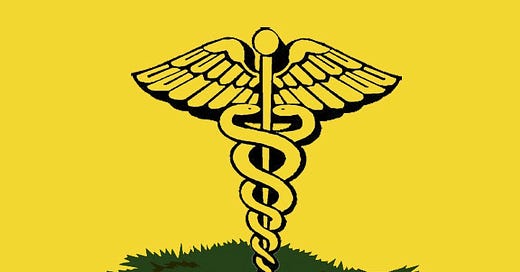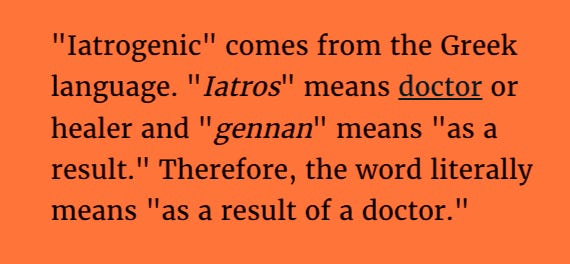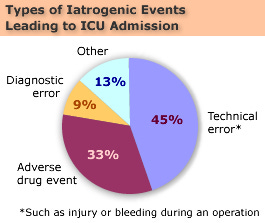There’s nothing more dangerous than doctors, hospitals, and the medical industry
Far worse than war, guns, crime, or car accidents — combined
If someone is killed in a terrorist attack, it’s headline news. If another person dies at the hands of police, it’ll be the top story for weeks. But when was the last time you saw breaking news about a deadly medical error? It’s at least the third leading cause of death in the U.S. but it’s so common that it rarely (if ever) warrants notice. Then, of course, there’s also the whole cover-up aspect of it all. We’re never supposed to question the infallible men and women in white coats, right?
Twelve years ago this month, I appeared on a panel at the Left Forum. The ostensible topic was animal rights but the conversations covered far more ground than that. Seated to my left on the panel was none other than Gary Null (photo above).
Back before the internet, I used to listen to Null on WBAI radio here in New York City. His eclectic show’s primary focus was on what might be called holistic health. Null never stopped questioning mainstream/corporate medicine and science. He’d regularly remind listeners about iatrogenic medicine.
That day on the panel, he loved my presentation but still tried to trip me up in front of the crowd during the Q&A. While talking about the environmental causes of cancer, he turned to me and asked if I knew the top* cause of death in the U.S. Without skipping a beat, I replied, “iatrogenic harm.”
Gary’s jaw hung open for a beat before he recovered and continued his monologue. I felt pretty good at that moment but also never forgot the importance of the point: There’s nothing more dangerous than doctors, hospitals, and the medical industry.
(*Null contributed to the definitive research on this topic and I will attempt to clarify the numbers as best as I can below.)
Gary Null was one of the first public figures to sound the trumpets about iatrogenic deaths but, fortunately, there are others. For example, Michael J. Saks and Stephan Landsman, authors of Closing Death’s Door: Legal Innovations to End the Epidemic of Healthcare Harm (Oxford University Press, 2021) explain:
“The causes of harm vary widely: slips of the scalpel, lapses like mixing up lab results, faulty decision-making, inadequate training, evasion of known safety practices, miscommunication, equipment failures, and many more. The ease with which medical errors can occur is striking. To perform a bronchoscopy to remove a sunflower seed that went down a 2-year-old’s airway instead of his esophagus, a doctor in New Mexico inadvertently sedated the boy with an adult dose of morphine, which caused him to stop breathing and led to severe permanent brain damage. A lab in New York state mislabeled a tissue sample, causing a woman who did not have breast cancer to get a double mastectomy while cancer kept growing inside the woman who had the disease. Surgeons still sometimes get left and right confused, and it’s not uncommon for patients to get the wrong medication or the wrong dose, as happened to Boston Globe health reporter Betsy Lehman, who died from an overdose of chemotherapy drugs that were miscalculated.”
Even the mainstream media admits that “medical errors” is the third leading cause of death and injury in the U.S. with the general figure being 250,000 lives lost per year. However, the British Medical Journal puts that number at 440,000.
But medical errors are only one component of the problem. Even when the “correct” treatment is given, it can cause countless injuries and death. And if you get any funny ideas about reporting these “healthcare heroes” for negligence, keep in mind that hospital medical records typically do not list incidents of doctor-induced harm or death.
“Death by Medicine” is a 2001 report by Gary Null, Ph.D.; Carolyn Dean MD, ND; Martin Feldman, MD; Debora Rasio, MD; and Dorothy Smith, Ph.D. It explains: “As few as 5 percent and no more than 20 percent of iatrogenic acts are ever reported. This implies that if medical errors were completely and accurately reported, we would have an annual iatrogenic death toll much higher than 783,936.”
A more recent estimate — factoring in adverse drug reactions, medically acquired bedsores, death caused by surgery, unnecessary procedures, and more — is 999,936 Americans per year killed by doctors and other medical “professionals.”
When they eventually factor in the iatrogenic deaths caused by deadly COVID protocols and vaccines, maybe then the public will finally catch on: Your doctor (with the pharmaceutical and insurance cartels behind him) might be the most dangerous person you know.
Keep yer guard up…









Thanks for this. So needed. Everyday I leave my 12 hour night shift as an RN my head spins because ppl still actually trust the system. We are healing beings. Every moment of every day our bodies are healing and moving toward balance. We’re constantly fucking it up with shitty food (exactly what hospitals feed ppl), shitty thoughts and lack of movement. Most nurses and docs don’t even believe in healing. They imagine the body is a machine. It’s embarrassing. I love being a nurse but it’s a shitshow. I pray I never end up in the system. It’ll likely collapse soon. I’ve only recently discovered that Rockefeller is likely who ruined medicine. A story I need to dig into more. Forces like the AMA mocked naturopathic, chiropractic and homeopathy so that money could be made with pharma. Of course there is a place for surgery, pharmaceuticals etc. but mostly we’re just treating bad lifestyle with toxic remedies. The documentary Escape Fire is worth a watch.
I wrote this in 2010:
One of the aspects of American life that destroys neighborliness is the perpetually expanding giant services sector of our economy, which is the fastest growing segment of our overall economy. This is the central focus of one of my favorite books, John McKnight’s The Careless Society. McKnight makes the astute point that service providers need an ever-increasing supply of clients in order to make a living, and thus we have developed an economic system that goes about clientizing citizens. Instead of seeking healthy lifestyle solutions and neighborly charity from friends we now tend to turn to professionals with the misguided hope they will therapize, medicalize, or social work us to health.
While this idea has been around since Aristotle, in the modern era this critique was most prominently put forward by Ivan Illich, who like McKnight, believed industrialized society was by its very function, causing deviance and illness. Illich lamented the counterproductivity of over-industrialized civilization and believed over-institutionalization was socially and culturally iatrogenic. He believed many institutions had become counterproductive to their original intent. If industrial society was to rediscover healthier living, according to Illich, it would need to deconstruct institutional systems and their reach so man could regain control over his environment. Illich’s words are especially meaningful today as we look at a behemoth health and social services system that is bankrupt and broken while the social, physical, and spiritual health of the population gets continually worse.
This understanding has created a lot of cognitive dissonance for me as a service provider as I have seen the way the American community has evolved toward a less healthy state to make room for our growing profession. The phrase for this phenomenon is social and cultural iatrogenesis – the proposed cure causes the illness. The incidence increase in depression, divorce, unwed parenting, and many other social maladies as the numbers in the services professions have grown, provides correlational evidence for social and cultural iatrogenesis. McNight and Illich are right, that we professionals need clients to expand our monetary bases. This phenomenon presents an awful paradox that our nation needs to face.
Assuredly, efforts to deconstruct this iatrogenic helping system will be met with tremendous opposition from those that have a monetary stake in maintaining or growing the existing system. However, I believe if we were to deconstruct the human services system in America in order to create more simplicity, effectiveness, and efficiency, the health of the nation would improve dramatically.